Nearly all U.S. national parks encompass the ancestral homelands of Native American Tribes. Having lived in, or at least traveled through, these areas, they left behind plenty of archaeological artifacts and other cultural heritage.
Particularly the rock art sites in national parks, created by Indigenous peoples many centuries ago, are fascinating places to visit. Today, you can see Native American rock art in several national parks, most of which are in the West.
This posts highlights some of the greatest, most interesting and most expansive national park rock art sites in the country.
Contents
- Rock Art in the National Parks: Pictographs and Petroglyphs, What’s the Difference?
- 7 Fascinating Sites With Pictographs, Petroglyphs and Rock Art in National Parks
- 1. Barker Dam Rock Art – Joshua Tree National Park, California
- 2. Wolfe Ranch Petroglyph Panel – Arches National Park, Utah
- 3. Signal Hill Petroglyphs – Saguaro National Park, Arizona
- 4. Newspaper Rock – Petrified Forest National Park, Arizona
- 5. Fremont Culture Petroglyphs – Capitol Reef National Park, Utah
- 6. Petroglyph Panel – Mesa Verde National Park, Colorado
- 7. Puʻuloa Petroglyphs – Hawaiʻi Volcanoes National Park, Hawaii
- Other Rock Art Sites in the National Parks
- More National Park Service Sites With Rock Art, Petroglyphs and Pictographs
- More Historic Places in the National Parks
Rock Art in the National Parks: Pictographs and Petroglyphs, What’s the Difference?
There are two different types of rock art in America’s national parks, which differ mainly in terms of how they’re created.
- Pictographs are images painted onto rock surfaces, using some type of coloring, dyes or other substances.
- Petroglyphs are images carved or pecked into rocks, using other rocks or tools.
You’ll have noticed that both pictographs and petroglyphs are images. The most common type of rock art you can see in national parks are petroglyphs, but some sites also preserve pictographs. Both are equally as fascinating, though.
Those rock images come in all kinds of variations. The National Park Service says they “take both abstract forms, such as spirals and lines, and recognizable animal or human shapes.”
Whichever object, action or living thing they represent, they are made to communicate something. Whether it’s a message, an annual event or even self-expression, they offer endless fascination to historians and park visitors alike.
Some places have so many pictographs or petroglyphs that an entire national monument was established to protect them. The best example of that is, of course, Petroglyph National Monument in New Mexico.
Below, however, I’ll focus only on national parks with rock art.
It might seem silly to leave out the one main National Park Service site that’s actually named after rock art, but there are plenty of other fascinating pictograph and petroglyphs sites in national parks, too.
This blog post about rock art in the national parks contains affiliate links. You can read more about our Terms of Use / Disclosure here.
7 Fascinating Sites With Pictographs, Petroglyphs and Rock Art in National Parks
1. Barker Dam Rock Art – Joshua Tree National Park, California
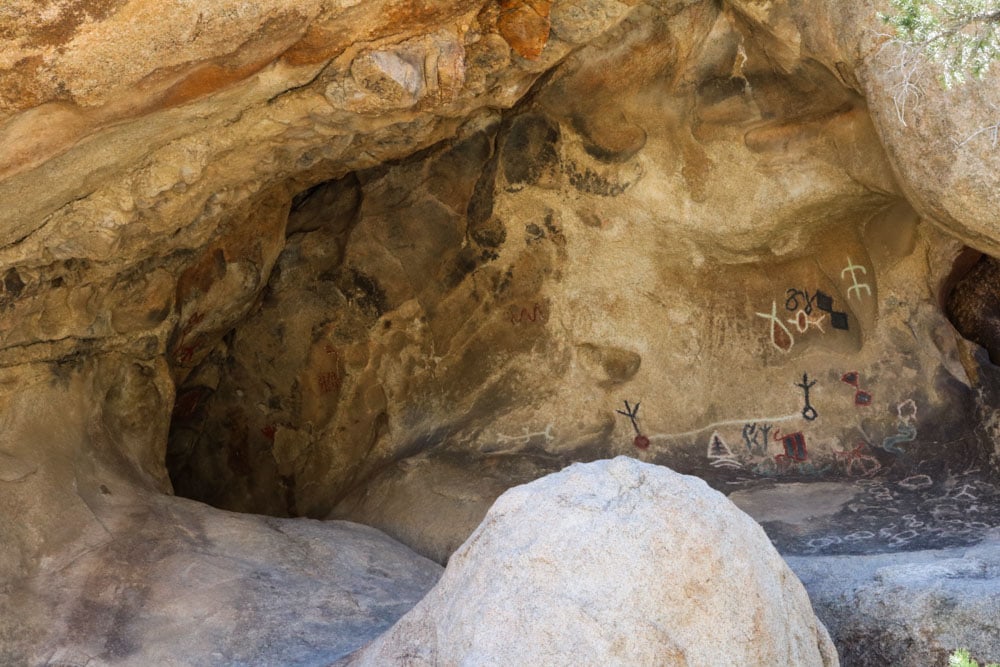
Joshua Tree National Park may be most famous for its iconic desert vegetation, world-class rock climbing and being a super-popular spring break destination, but it has some culture to offer, too.
Besides abandoned gold mines and historic ranches, the park also has several (hidden) rock art sites.
The most accessible Joshua Tree National Park rock art is along the Barker Dam Trail, an easy 1.1-mile loop. On this scenic Joshua Tree trail, you can immerse yourself in the park’s iconic boulder-strewn desert landscape, dotted with Joshua trees.
The trail runs past a nice rock art site, which “tells the story of the desert’s human history.”
The Park Service reminds people to not climb on, touch or disturb the rock itself, since rock art may not be visible to the untrained eye. The site is clearly signed along the trail and you can view the rock art from a respectful distance.
2. Wolfe Ranch Petroglyph Panel – Arches National Park, Utah
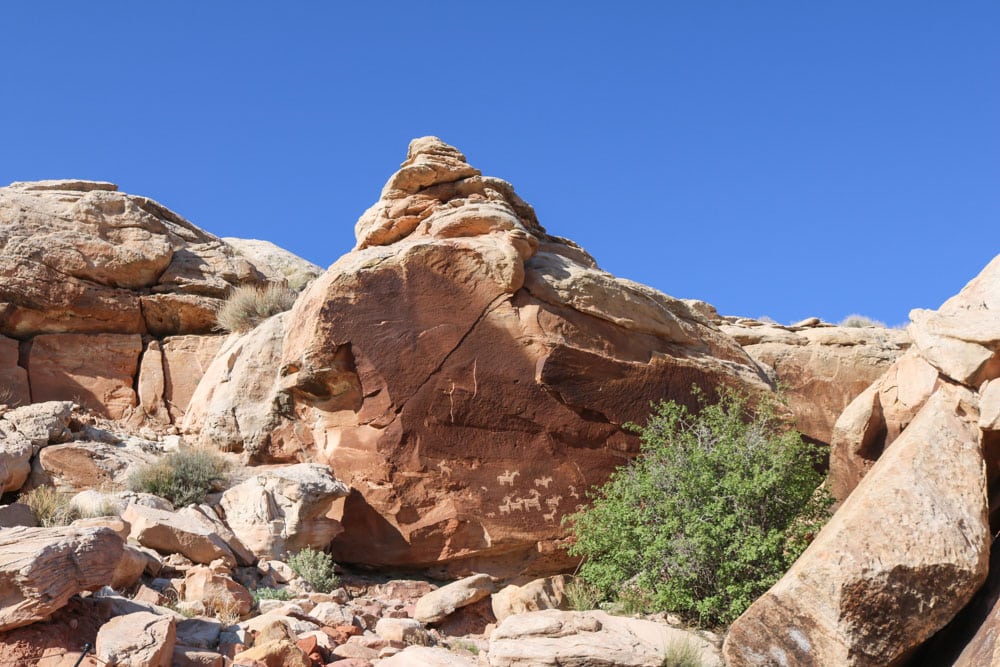
Although it’s named after a Civil War veteran and his son, the Wolfe Ranch area in Arches National Park is also home to a pretty amazing petroglyph panel.
The historic ranch cabin is undoubtedly interesting, but Native American history buffs will be more interested in the so-called Ute Panel.
Carved between 1650 and 1850, these petroglyphs feature a horse and rider surrounded by several bighorn sheep. The carvings also display dog-like animals, a particular scene that is typical of rock art made by the Ute Tribe.
Although the exact time these Arches National Park petroglyphs were created isn’t known, the presence of horses indicates they date from after the introduction of horses to North America in the mid-1600s.
In addition to the Ute Panel and Wolfe Ranch, this area is where you’ll find the trailhead for the 3-mile roundtrip Delicate Arch Trail, too.
3. Signal Hill Petroglyphs – Saguaro National Park, Arizona
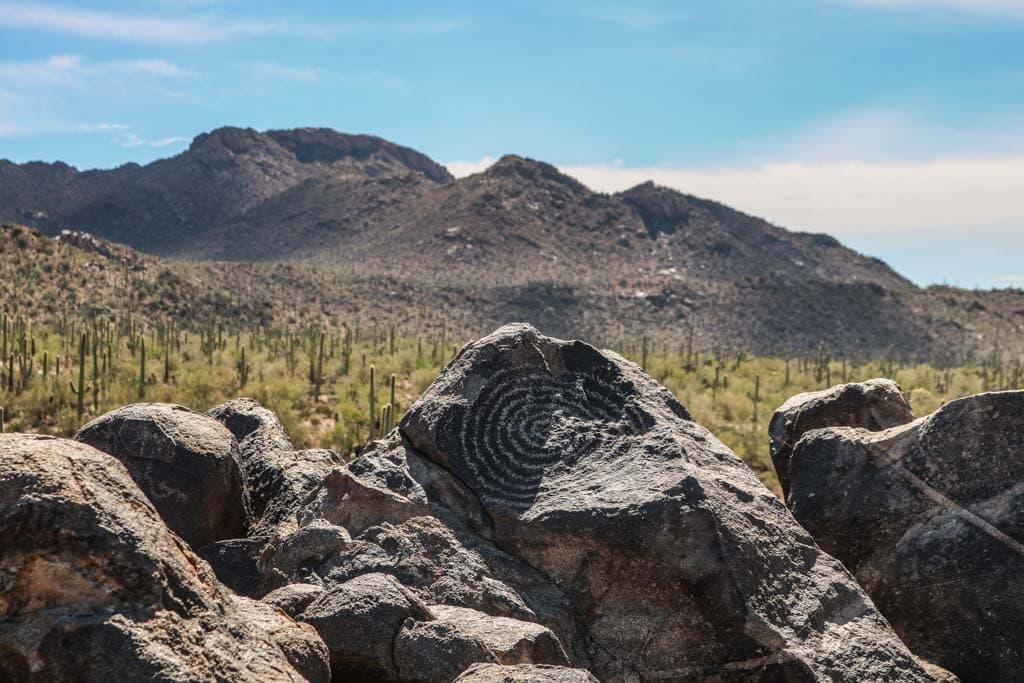
Saguaro National Park is another of the many national parks in the Southwest that have rock art sites.
In this Arizona national park, you can easily see Native American rock art on the easy Signal Hill Trail. Located in the park’s Tucson Mountain District just west of Tucson, the trail gently runs up a hill, ending at an 800-year-old petroglyph site.
This beautiful rock art was created by the prehistoric Hohokam people.
They made these images by “etching, pecking or scraping designs into the dark patina found on the surface of sandstone and other rocks” in Saguaro National Park, the National Park Service explains.
4. Newspaper Rock – Petrified Forest National Park, Arizona
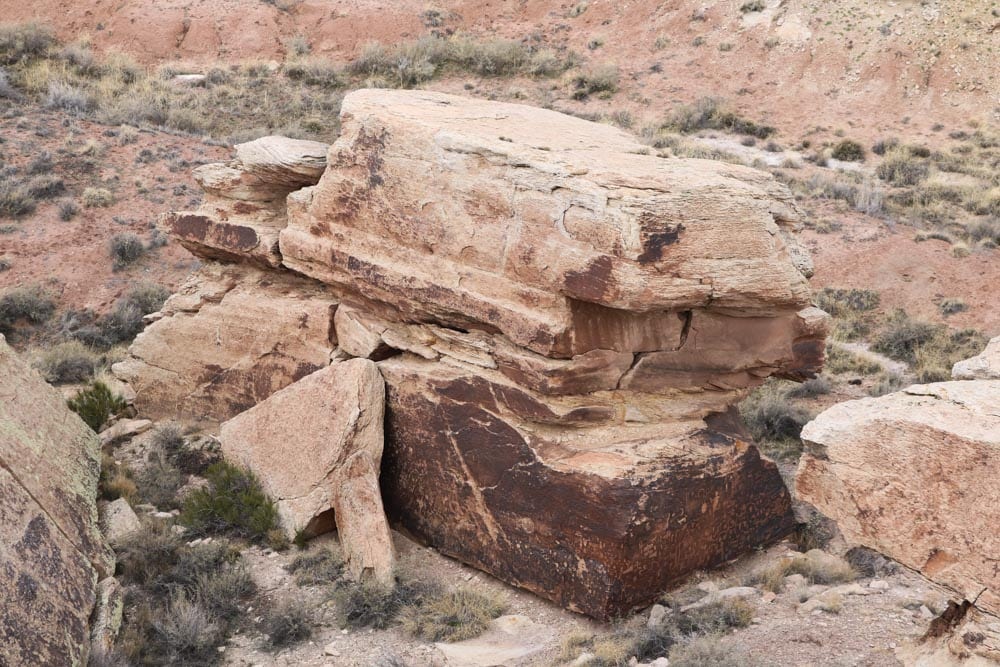
Despite its name suggesting otherwise, Petrified Forest National Park’s Newspaper Rock is neither a newspaper not a single rock.
This is the general name of a national park rock art site that encompasses more than 650 petroglyphs on multiple rock surfaces.
This sheer number of petroglyphs in a small area means the site was very important to the Native Americans who used to live here. In fact, many generations of people visited this site and left their own markings.
Newspaper Rock, which is visible from an overlook, is a collection of Ancestral Puebloan petroglyphs dating from 2,000 to 650 years ago.
The Ancestral Puebloan people lived, farmed, cooked and hunted along the Puerco River for hundreds of years.
Several of the people who made this rock art may have called nearby Puerco Pueblo, one of the highlights of Petrified Forest National Park, home.
Created and added throughout many centuries, the Newspaper Rock markings reflect a rich culture, but are difficult to “read.” They include everything from family symbols and spiritual designs to migration routes and calendar events.
5. Fremont Culture Petroglyphs – Capitol Reef National Park, Utah
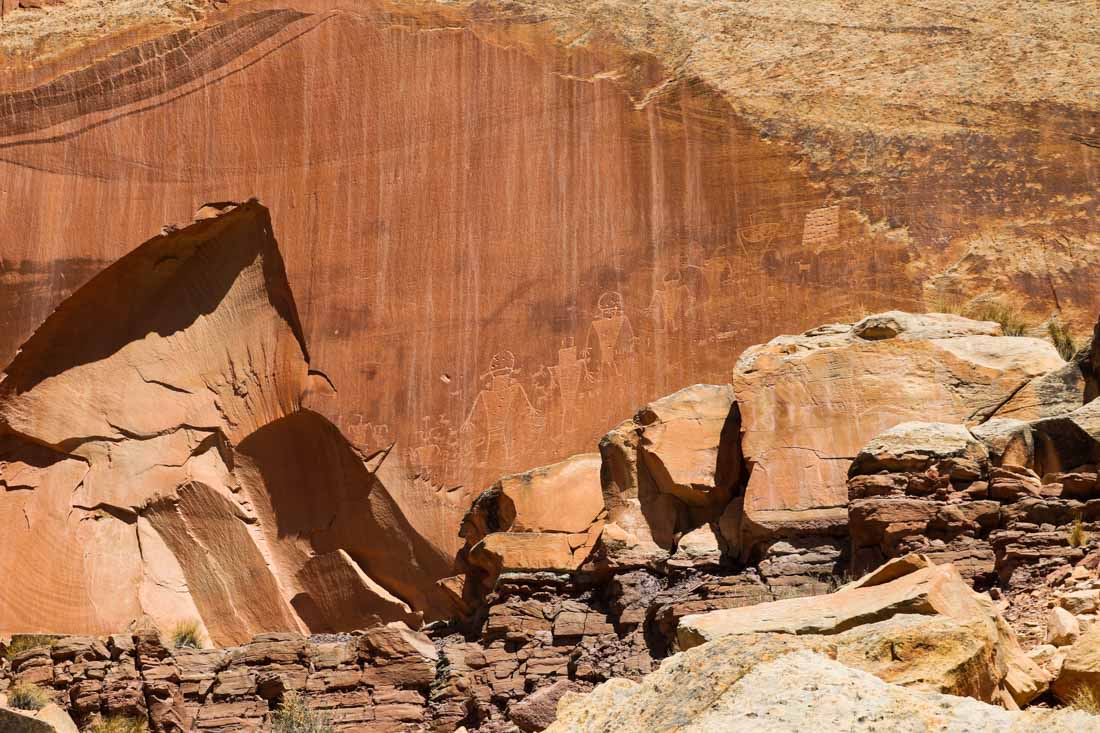
From 700 to 1,700 years ago, Utah was the home of the Fremont Culture, a thriving society of bands of hunter-gatherers and farmers.
They survived in the arid environment of the Southwest for a thousand years, leaving behind ruins of rock shelters and pit houses, tools and other artifacts, and, of course, petroglyphs.
The best place to see these fascinating Fremont Culture petroglyphs is on Utah State route 24 through Capitol Reef National Park. Two wooden boardwalks offer access to this centuries-old rock art.
The longest of the two boardwalks runs along the cliff face and gets closest to the petroglyphs. However, because time has covered them with a patina, this particular set of petroglyphs is harder to see.
The shorter boardwalk, on the other hand, is arguably the best one. It leads to a viewing area where you can see numerous anthropomorphic petroglyphs. Additionally, there are also many petroglyphs of bighorn sheep, other animals and geometric shapes.
Depending on the time of day, the petroglyphs in Capitol Reef National Park can sometimes be difficult to see, though. Bring a pair of binoculars to view them better.
6. Petroglyph Panel – Mesa Verde National Park, Colorado
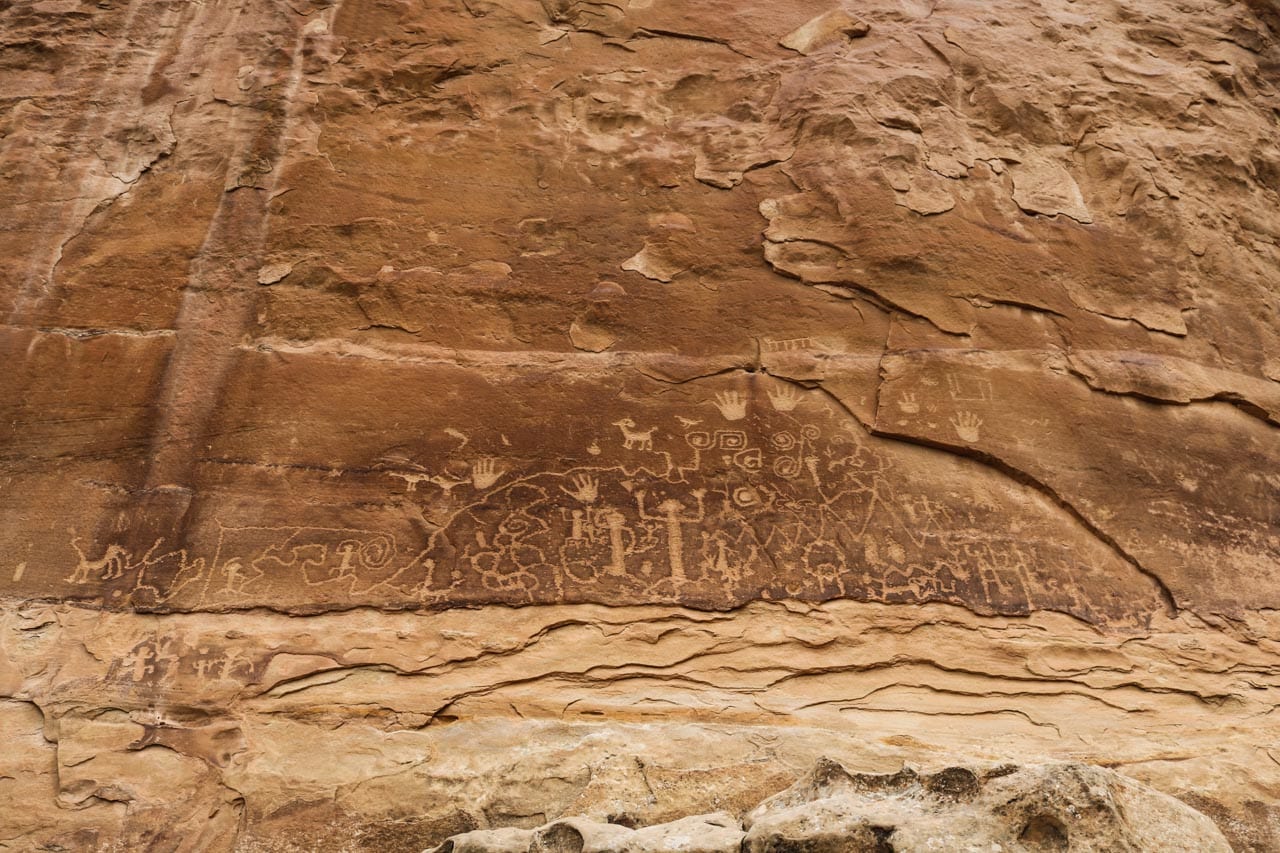
Without question to greatest national park for Native American sites, Mesa Verde National Park in southwestern Colorado is world-renowned for its cliff dwellings.
There are no fewer than 600 of them, along with literally thousands of other archaeological sites.
The most famous cliff dwellings at Mesa Verde are Balcony House, Long House, Spruce Tree House, Square Tower House, and Cliff Palace. You can visit them on guided ranger tours.
With this huge number of archaeological sites, it’s no surprise that Mesa Verde National Park has its own petroglyphs, too.
The appropriately named Petroglyph Point Trail runs directly past a magnificent petroglyph panel. It’s a 2.4-mile loop hike—the petroglyphs are about 1.4 miles from the trailhead.
This large petroglyph-covered rockface “represents the language of the people who inhabited and traveled through this canyon,” the National Park Service says. “More than thirty human and animal figures, spirals and handprints cover an area of 35 feet wide.”
The Petroglyph Point Trail runs through scenic Spruce Canyon. It follows an ancient Ancestral Puebloan trail that once connected Spruce Tree House with other local communities, as well as the rest of the Pueblo world.
7. Puʻuloa Petroglyphs – Hawaiʻi Volcanoes National Park, Hawaii
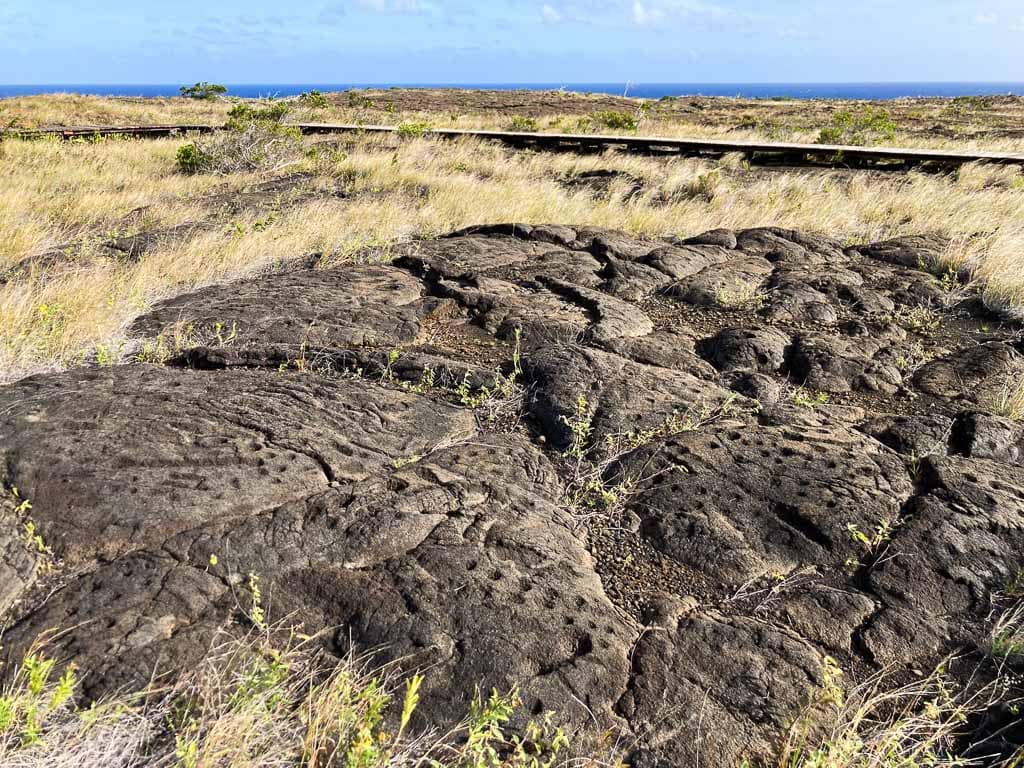
In Hawaiʻi Volcanoes National Park, you can “walk in the footsteps of the kūpuna (elders) to Puʻuloa (hill of long life), a sacred and awe-inspiring gallery of kiʻi pōhaku (images carved in stone).”
Located near the end of the Chain of Craters Road, the Puʻuloa Petroglyphs Trail is one of the top hikes in Hawai‘i Volcanoes National Park for Native Hawaiian heritage.
The destination of this wonderful hike is the largest field of petroglyphs in Hawaii.
Sprawling across a large area of 500-to-550-year-old lava, this site contains no fewer than 23,000 petroglyphs. Dozens upon dozens of those are visible from a boardwalk at the end of the trail.
This is a great place to get a better understanding of the life, beliefs and customs of the Native Hawaiian people.
Most of the petroglyphs you can see here are cup-like carvings, known as poho, which cradled the umbilical cord, or piko, of newborn babies. This practice gave hope that the child would enjoy a long and prosperous life.
Other petroglyphs at Puʻuloa are circles, canoe sails, cryptic motifs, straight lines and anthropomorphic figures.
Other Rock Art Sites in the National Parks
Besides the remarkable rock art sites in national parks above, there are other national parks with petroglyphs and pictographs.
From Washington to Texas and even the U.S. Virgin Islands, you can find more rock art at the following parks.
- Horseshoe Canyon – Canyonlands National Park, Utah
- Indian Head Petroglyphs – Big Bend National Park, Texas
- Reef Bay Petroglyphs – Virgin Islands National Park, U.S. Virgin Islands
- Wedding Rocks Petroglyphs – Olympic National Park, Washington
More National Park Service Sites With Rock Art, Petroglyphs and Pictographs
There are numerous other National Park Service units with rock art, too.
The most famous example, as mentioned above, is New Mexico’s Petroglyph National Monument, but there are pictograph and petroglyph sites all over the American West.
- Dinosaur National Monument, Colorado and Utah
- Petroglyph National Monument, New Mexico
- El Morro National Monument, New Mexico
- Chaco Culture National Historical Park, New Mexico
- Organ Pipe Cactus National Monument, Arizona
- Grand Canyon-Parashant National Monument, Arizona
- Alibates Flint Quarries National Monument, Texas
- Nez Perce National Historical Park, Idaho
- Lava Beds National Monument, California
Which of These National Park Rock Art Sites Have You Visited? Share Your National Parks Experience Below!
More Historic Places in the National Parks
- Best National Parks for Dinosaurs and Other Fossils
- Greatest Historic Lodges, Hotels and Resorts in the National Parks
- Presidential National Parks: Birthplaces, Homes, Monuments & Memorials
- National Parks Dedicated to African-American History
- National Park Service Sites That Preserve Latino / Hispanic Heritage
